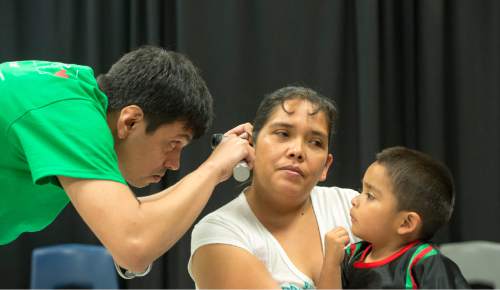This is an archived article that was published on sltrib.com in 2016, and information in the article may be outdated. It is provided only for personal research purposes and may not be reprinted.
Utah is worst in the nation for enrolling Latino children for health insurance, a new study says.
Nearly 1 of every 4 is uninsured — 23.4 percent to be exact. That is more than double the national average of 9.7 percent, according to a report released Friday by Georgetown University's Center for Children and Families and the National Council of La Raza.
"And Utah has a really high rate of children who are eligible but are not enrolled in public health insurance programs," likely because of poor outreach and confusing rules and application processes, says Jessie Mandle, health policy analyst for Voices for Utah Children.
The study, which analyzed U.S. census survey data, estimated that 36,005 Latino children under age 18 in Utah were uninsured in 2014, the first year of the Affordable Care Act (ACA). That's roughly the population of Cottonwood Heights.
While 23.4 percent of Latino children are uninsured in Utah, only 8 percent of white children here are, according to separate U.S. census data.
The study said that uninsured rates for Latino kids nationwide hit an all-time low in 2014 as the ACA, or "Obamacare," expanded care options and provided some subsidies.
But in Utah, the number of uninsured Latino kids went the other direction — and actually jumped by an estimated 2,454 children.
The study notes that 17 percent of all Utah children are Latino, and that percentage is growing. It adds that Latinos are expected to make up a third of the U.S. workforce by 2050.
"We need to make sure that all Utah's children, including Hispanic children, have access to health insurance that gives them a strong foundation for the future," said Sonya Schwartz, a research fellow at the Georgetown center and co-author of the report.
Among Utah Latino kids, "93 percent are here legally," Mandle said, so most are not undocumented immigrants who legally cannot qualify for government insurance programs such as Children's Health Insurance Program (CHIP) or Medicaid.
"Children can actually qualify at levels that their parents can't," Mandle said.
For example, children in Utah families that earn up to 205 percent of the federal poverty level can qualify for CHIP or Medicaid, but their parents qualify only if they make much less — between 55 percent and 133 percent of the poverty level.
"So there is a real gap," Mandle said. "When parents don't have insurance, you see their children are less likely to be enrolled as well, just because parents think that because they are not eligible, their children also are not eligible."
The study says that can be reversed through what it calls a "welcome mat" effect. It found that when parents signed up for newly available ACA coverage, they were more likely also to sign up children who had previously qualified for CHIP or Medicaid but had not been enrolled.
The new study also said Latino children are more likely to have health insurance in states that have eliminated a five-year wait for legal-immigrant children to become eligible for CHIP and Medicaid, or where they have expanded Medicaid to include more low-income people.
Utah has not taken either step, and Mandle's group is calling for that to change.
Gov. Gary Herbert has proposed a variety of alternative formulas to expand Medicaid over the past year to take advantage of money from the ACA — and has been supported by the Utah Senate — but conservatives in the House have blocked it.
Senate President Wayne Niederhauser, R-Sandy, said earlier this week that he expects the upcoming session of the Legislature again to consider methods of expanding Medicaid coverage.
Mandle would also like Utah to allow one year of "continuous eligibility" for children on Medicaid — meaning they would have coverage for 12 months even if a change in income or family status may not allow them to renew. Currently, they are cut off when their situation changes.
"So you can work hard to get a family enrolled, and then their parents get seasonal or temporary work — and they lose that Medicaid. Then they have to re-enroll," Mandle said. "Without continuous eligibility, parents are penalized for trying to improve their family's economic circumstances through temporary or seasonal work."
Mandle added that another problem is that "there is a lot of misinformation" about who qualifies for government insurance programs, and how to navigate confusing applications. "So there is need for more outreach about who is eligible and how to keep it once you have it," Mandle said, adding that she hopes for better state funding of such efforts.



